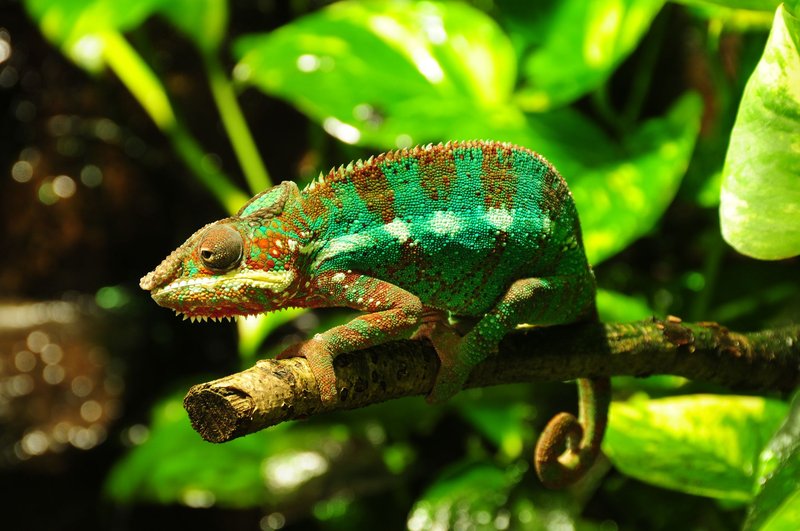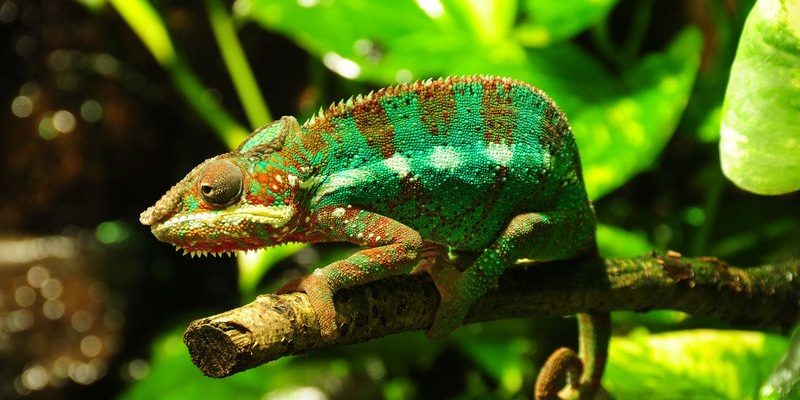
Now, the Panther Chameleon has some unique tricks up its sleeve. You might picture it navigating the dry forests of Madagascar—its home—where the heat can be overwhelming, and water sources are scarce. Here’s the thing: this little reptile has evolved over time to deal with these challenges in remarkable ways, making it a fascinating case study in nature’s resilience.
Understanding the Panther Chameleon’s Habitat
To appreciate how these chameleons survive, it’s essential to know where they live. The Panther Chameleon primarily resides in Madagascar, a place full of diverse ecosystems. From rainforests to scrublands, it faces a variety of climates.
In the dry regions, the chameleons find shelter under leaves, using camouflage to blend in with their surroundings. This isn’t just for show; it’s a clever way to avoid predators. Think of it like a sneaky magician, disappearing into the background. These habitats can get extremely hot during the day, so the chameleons often become more active in the cooler hours.
Interestingly, they have favorite spots, such as branches or bushes, where they can bask in the sun or hide from potential threats. Their ability to navigate these environments is crucial for their survival.
Color Changing: More Than Just A Party Trick
You might think of the Panther Chameleon as a flashy character, constantly changing colors like a disco ball. But this ability serves a purpose beyond impressing you at a party. Color change is primarily a way for these lizards to communicate and regulate their body temperature.
When a Panther Chameleon feels hot, it can turn lighter to reflect sunlight, helping it cool down. Conversely, when it’s time to warm up, it might darken its skin to absorb more sunlight. Imagine standing in the sun without sunscreen—after a while, you’d want to adjust your shirt to stay comfortable. A similar principle applies here.
Additionally, color changes can signal emotions or intentions to other chameleons. For instance, a bright display might indicate readiness to mate or show dominance, while darker tones can suggest stress or fear. This dynamic way of communicating adds another layer to their survival strategy in harsh environments.
Water Conservation Strategies
Living in environments where water can be scarce means that the Panther Chameleon has developed some clever methods to conserve moisture. These lizards are known for their keen ability to absorb water from their environment. You might spot them drinking rainwater droplets off leaves or even collecting dew.
A unique behavior involves “drinking” the fog. In their habitat, morning fog can settle on vegetation, and the chameleons take advantage of this by licking the moisture from leaves. It’s like having a built-in water bottle!
Moreover, by staying inactive during the hottest parts of the day, they reduce their need for water. Think about how you might avoid running around outside during peak sun hours; these chameleons do the same to keep hydrated and healthy.
Adapting to Temperature Changes
Temperature fluctuations can be brutal, especially in regions with intense heat during the day and cooler nights. The Panther Chameleon has adapted to these extremes in a few interesting ways.
First, their behavior plays a significant role. During the daytime, they tend to bask in the sun to warm up. As temperatures drop at night, they seek shelter in thick foliage to stay warm. It’s like how you might snuggle under a blanket on a chilly night or sit near a heater when it’s cold.
In addition to behavior, physiological adaptations also kick in. Their bodies can tolerate a range of temperatures, allowing them to function well even when conditions are less than ideal. For the Panther Chameleon, staying one step ahead of the climate is key to surviving in Madagascar’s unpredictable weather.
Predator Evasion Tactics
Any creature living in the wild faces predators, and the Panther Chameleon is no different. Their survival hinges on a combination of clever tactics to evade being caught.
One of their primary defense mechanisms is camouflage. With their ability to change color, they can blend seamlessly into their surroundings, making it challenging for predators to spot them. Picture yourself wearing camouflage gear; you’d be hard to find, right? The same logic applies here.
Additionally, when threatened, these chameleons can freeze and remain motionless. This strategy helps them avoid detection. If a predator approaches, they might simply change to a color that blends with the nearby vegetation. It’s a survival skill that’s essentially an art form.
Feeding Habits and Energy Management
The way Panther Chameleons eat also reflects their need to survive in harsh environments. They’re primarily insectivores, feeding on a diet of crickets, locusts, and other small insects. This diet is not only easy to find in their habitat but also offers the right amount of energy they need.
Chameleons use their long, sticky tongues to capture prey quickly. Think of it like a baseball player catching a fly ball—quick reflexes and great aim are crucial! Once they secure their meal, they can absorb all the nutrients necessary to thrive.
Energy management is key for them, as they need to balance their activity levels with food intake. By hunting efficiently and conserving energy when possible, these lizards keep themselves fit and ready for whatever challenges the environment throws their way.
The Importance of Social Behavior
You might not think of chameleons as social animals, but they do have social behaviors that contribute to their survival. Communication plays a vital role in helping them navigate their world, from courtship during mating season to warning others of danger.
Interestingly, Panther Chameleons often engage in territorial displays. Males, in particular, will change colors to assert dominance over an area. This display can deter rivals without the need for physical confrontation, which is energy-consuming and risky. It’s a bit like how people might argue or puff up their chests to assert themselves, but these chameleons prefer showing off their colors instead.
Their social interactions extend to finding mates, where bright, vibrant colors attract potential partners. This method of communication is essential for ensuring the continuation of the species in their challenging environment.
In conclusion, the Panther Chameleon is a stunning example of nature’s ability to adapt and survive in harsh conditions. From their clever color-changing abilities to their water conservation strategies, these lizards showcase the remarkable resilience of life. Whether they’re blending into their environment or dodging predators, they remind us of the beauty of adaptation. So next time you see a chameleon, think of it not just as a colorful creature but as a survivor in the wild, thriving against the odds.

